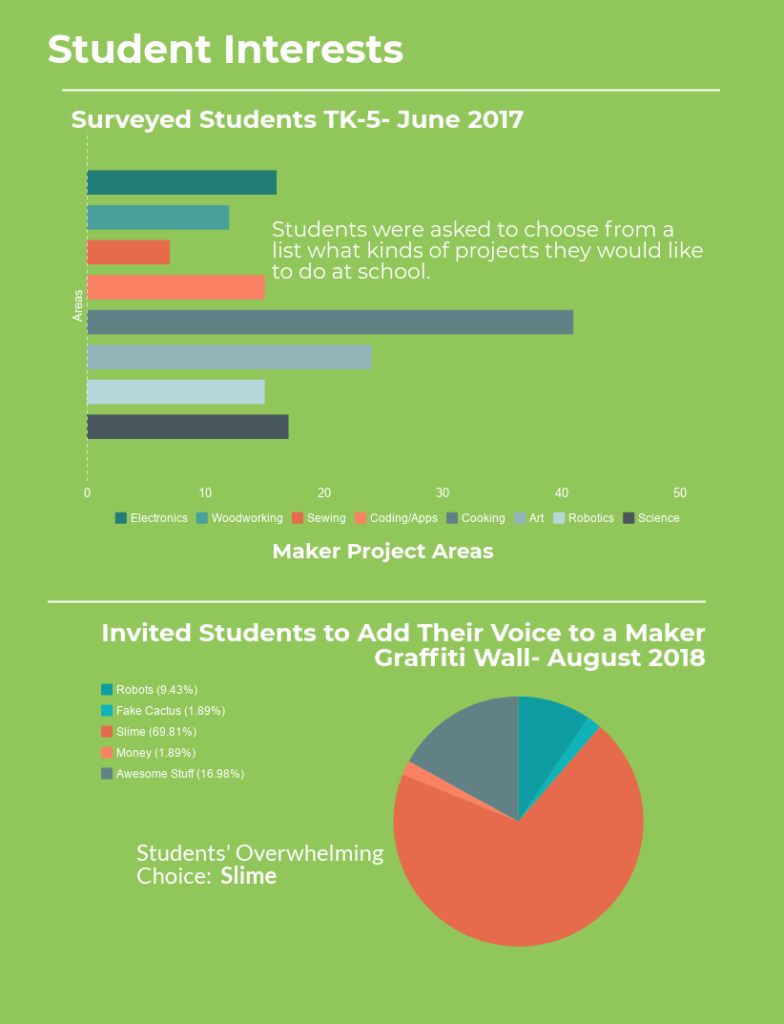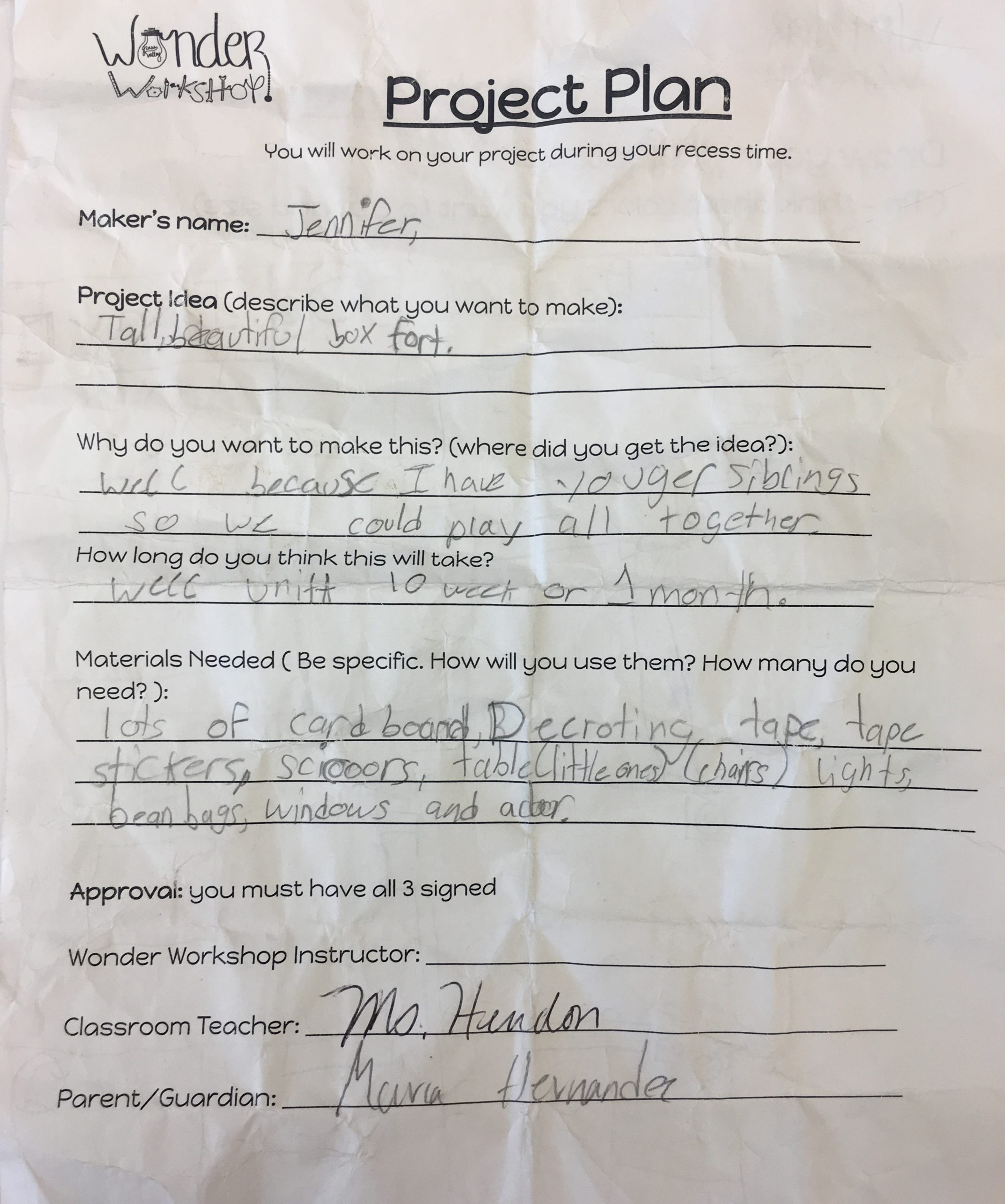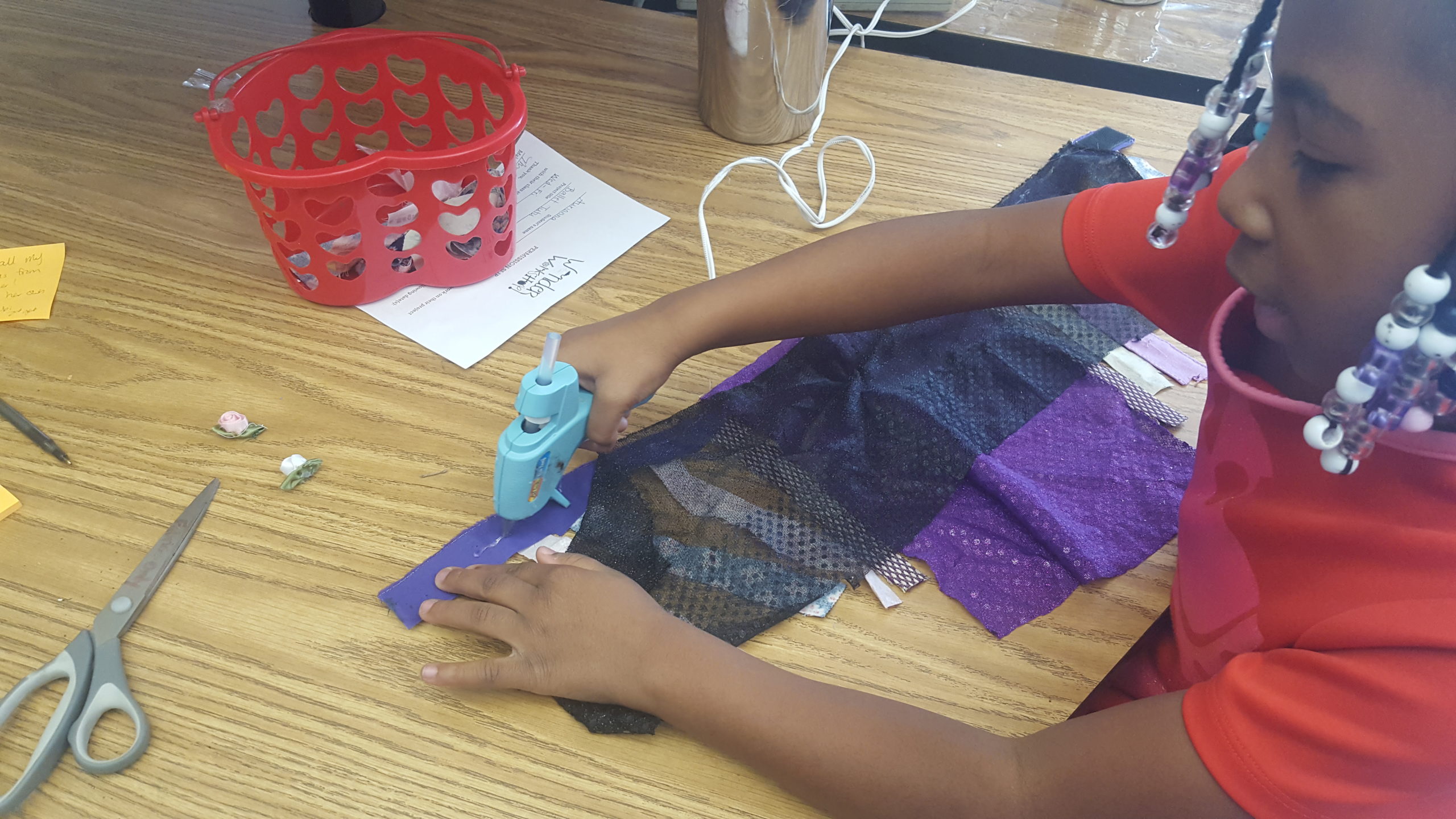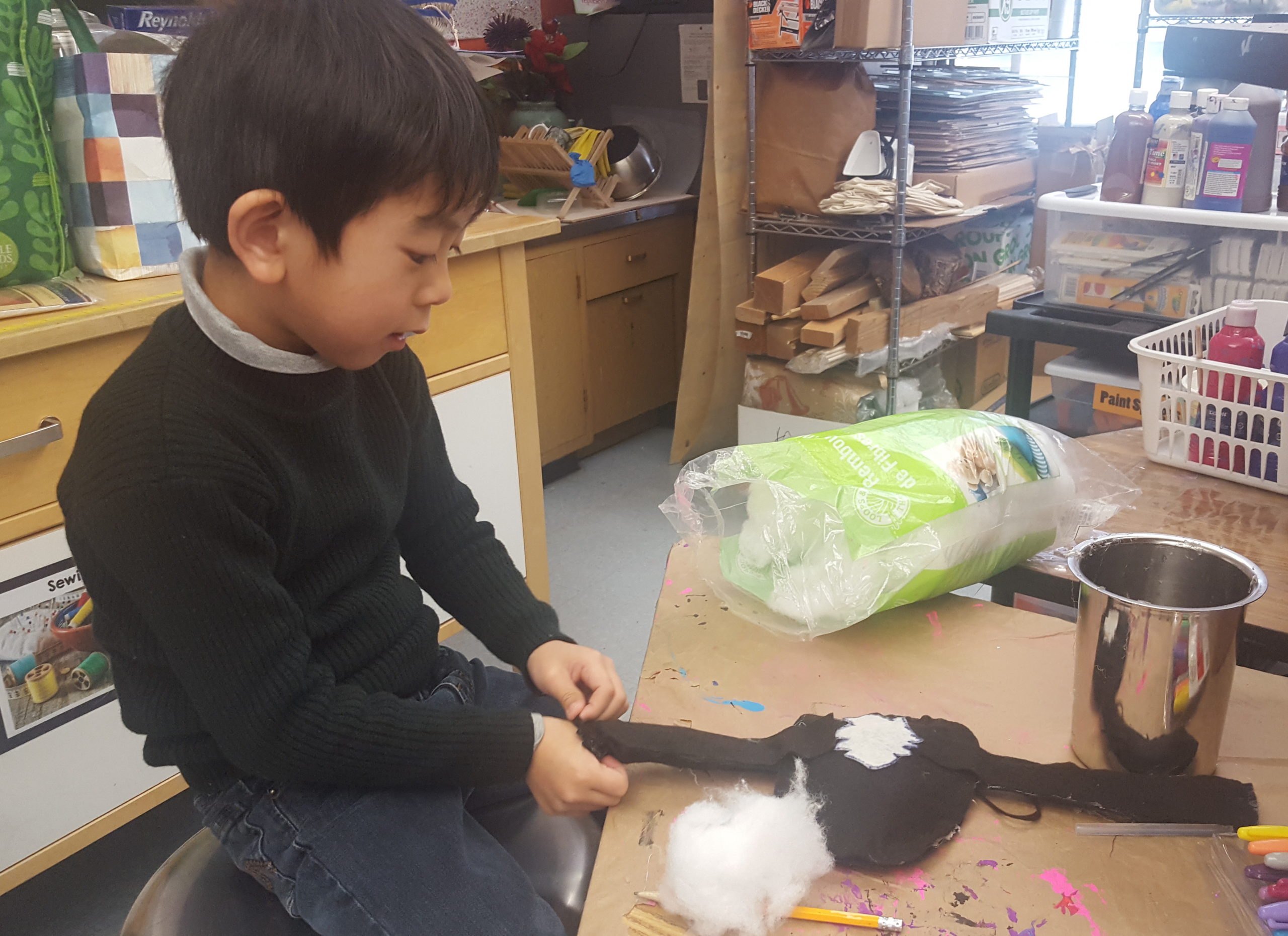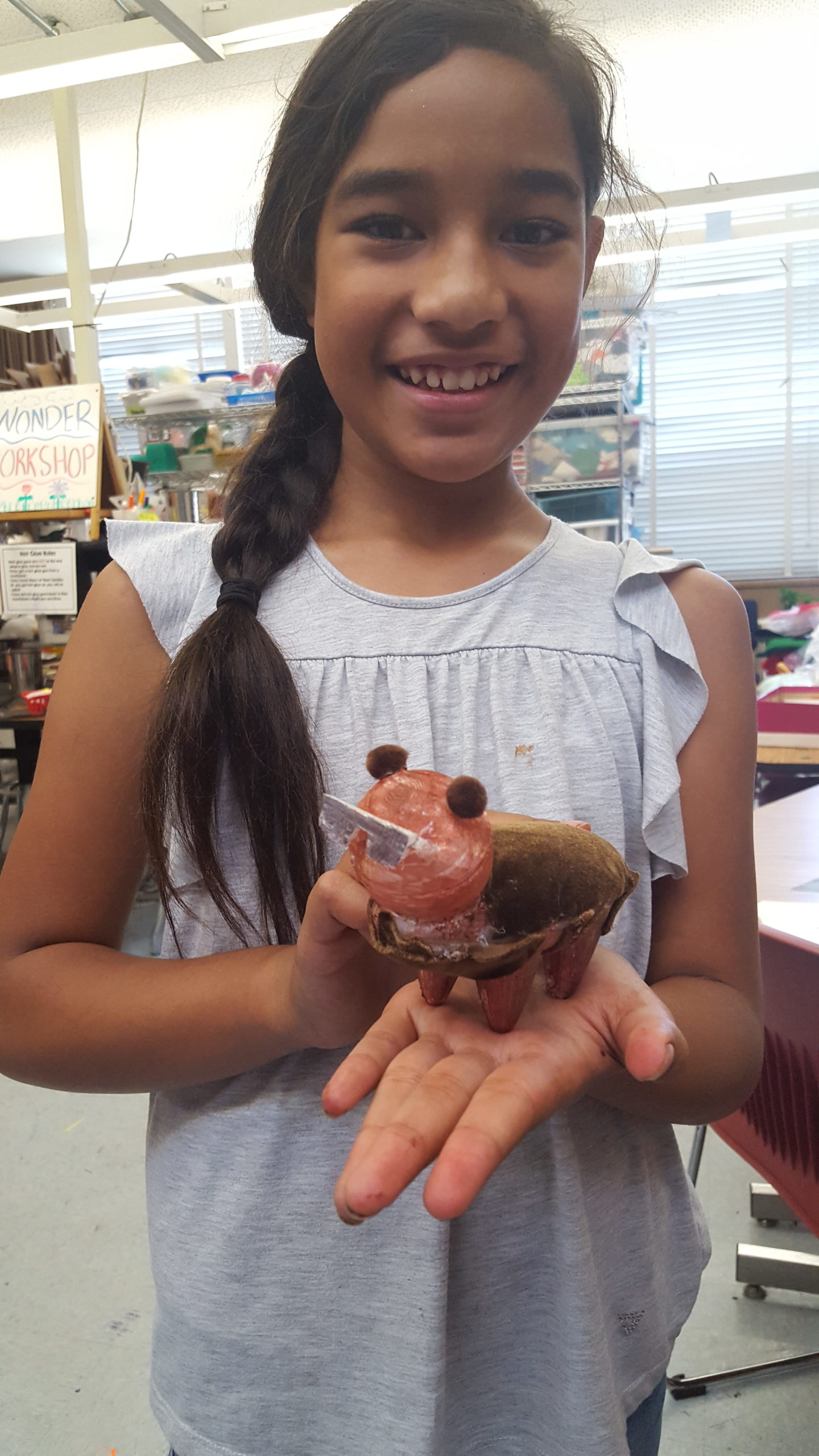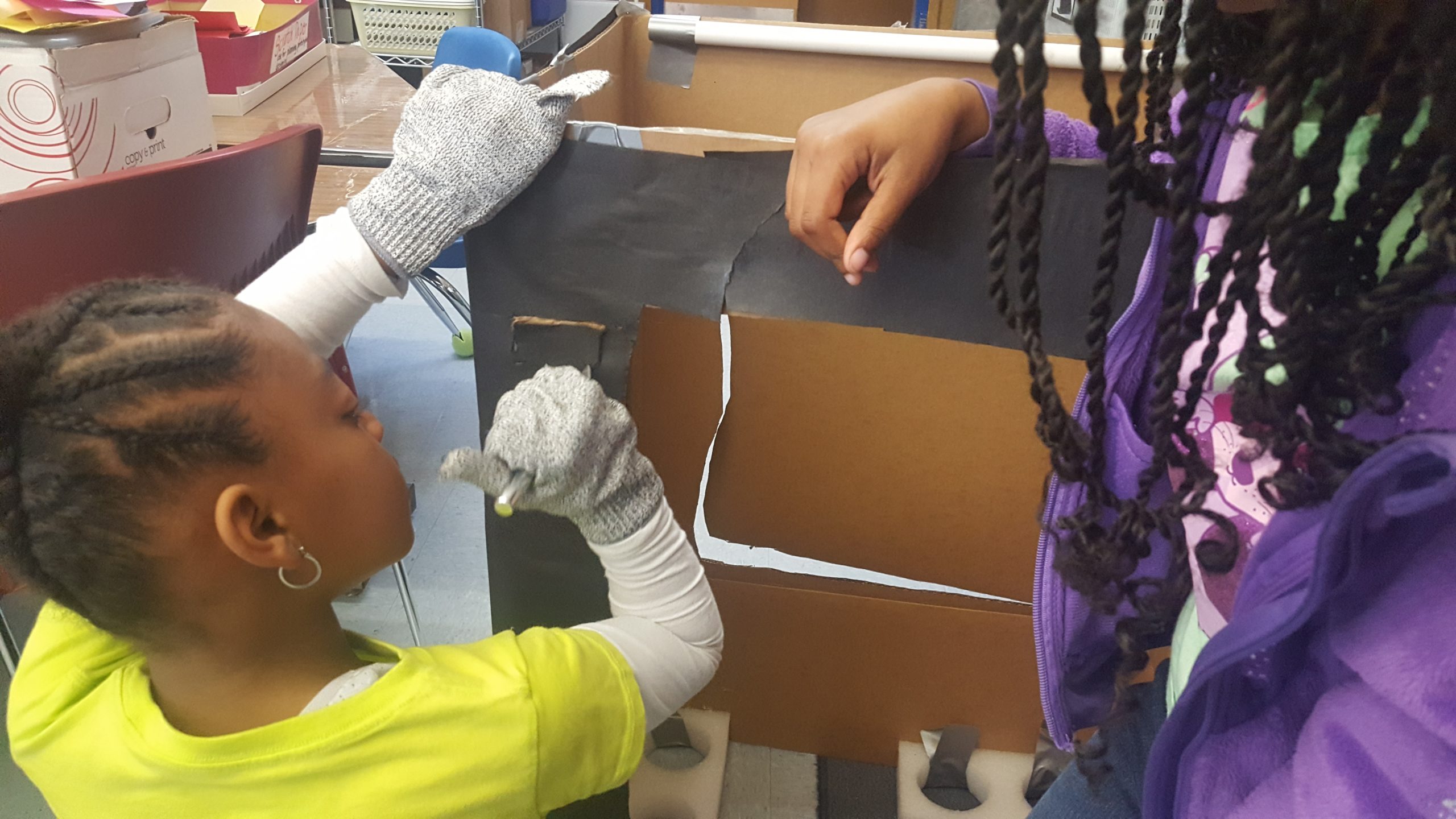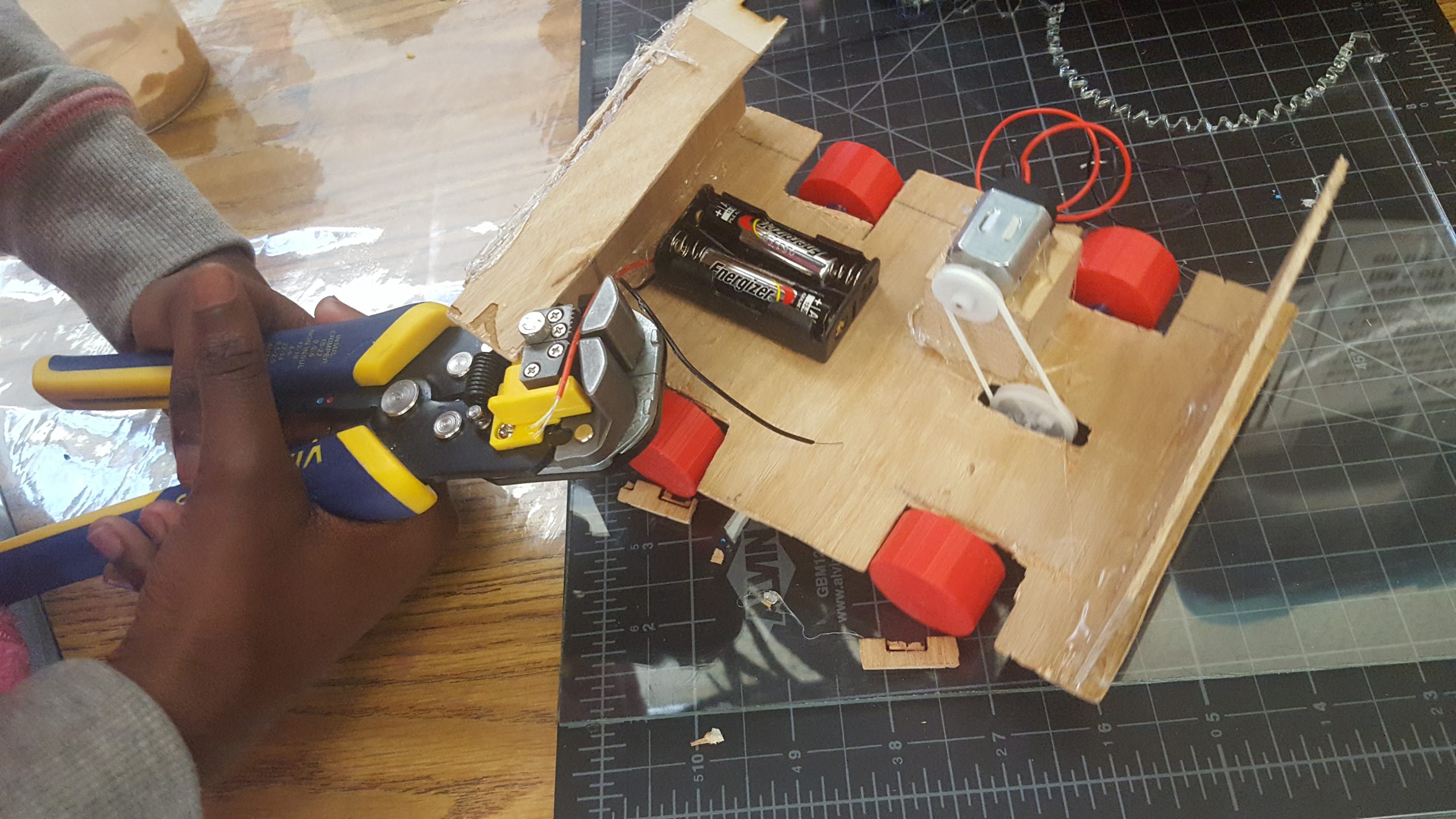Lessons in Linked Learning and Maker Education from the Wonder Workshop
Curators notes:
As a small public school in Oakland, California embarked on a culture shift, these educators moved away from whole-class, lockstep instruction, and toward small-group, personalized learning with differentiated instruction based on students’ interests and needs.Summary:
Teachers at Grass Valley Elementary engage young people in exploring their interests and found that Project Based Learning with a focus on Maker Education increased student engagement and empowerment. Included are examples of student work, links to Maker kits, prompts, and templates. Second graders testing circuits and motors; getting ready to make motorized toy cars.
Second graders testing circuits and motors; getting ready to make motorized toy cars.
What do you get when you tell students they can make anything they want as long as they are willing to put in some time to achieve their dreams?
That’s what the Maker Leadership team at Grass Valley Elementary wanted to find out. Among other things, we wanted to bring joyful learning (a casualty of No Child Left Behind) back into school. One way to do this, we decided was to connect students’ home interests with our school’s Maker Education program. Our hypothesis was that increased student engagement and empowerment would be the result.
A bit of background:
Grass Valley Elementary is a small public school in Oakland, CA. with a unique school community. Our student population is 99.9% students of color mainly coming from under-resourced neighborhoods with one third of our students receiving special education services. Typically these kind of statistics do not lead to success however at Grass Valley we have never let statistics tell our whole story.
During the 2014-2015 school year, our principal and staff began discussing ways to bring fun, along with high levels of rigor, back into our classrooms. We realized that more could be done to engage students and keep them excited and interested in school. We determined that student-centered learning and instruction was the route forward, and started the process of changing our school’s culture. We began moving away from whole class, lockstep teacher directed instruction, and towards small group, personalized learning with differentiated instruction based on students’ individual needs and interests. Although we had no money in our budget to make this change happen, we still believed that through hard-work and leg-work we could affect change at our site. After doing our own research and attending workshops, we decided that Project Based Learning (PBL), with a focus on Maker Education, would allow us to engage young people in exploring their interests and ignite a life-long love of learning.
Once we began piloting our PBL/Maker Ed program in the 2015-2016 school year, we found that student engagement increased during the time teachers spent implementing maker units. But most of these initial units started and ended with the teacher’s vision for the projects. Our team of Maker Leaders (two general education and two special education teachers) wanted to shift our focus to student interest driven projects as a way to develop student agency. Our goal was to empower students to see themselves as change agents in our school and within their communities. During our planning meetings, we discussed ways to bring greater student voice and student interests into our trimester classroom projects. We started asking students more often about what they were interested in creating or how they would approach a problem. Student engagement increased again.
However, I still felt we could do more to elevate student voice so in the winter of the 2016-2017 school year, I opened up our school’s brand new makerspace, the Wonder Workshop, for individual student projects. With the assistance of the two Americorps Maker VISTA members who were working at our site, we expanded the individual projects into Recess Making sessions. In short order, every recess slot was filled with students who wanted to make. Fast forward to the spring of 2017 when we learned that our little school was one of ten nationwide that had been chosen for the LRNG Innovators Challenge grant. It was time to kick our work into high gear. We knew that linking learning to students’ interests was absolutely the way forward.
In June of 2017, our team sent out a survey to all the classrooms to find out what interested students most. The Maker Leadership Team (three classroom teachers, the librarian, the two Americorps Maker VISTAs and myself) used those results to inform our summer planning where we outlined Maker units for the next school year, sourced materials and other resources. Once students returned for the 2017-2018 school year, we wanted to see if any of their interests had changed. We hung up a simple graffiti wall outside the Wonder Workshop and posted signs asking students “What do you want to make?” With such an open ended question, the answers ended up being quite different from the structured survey given in June. The results were surprising.
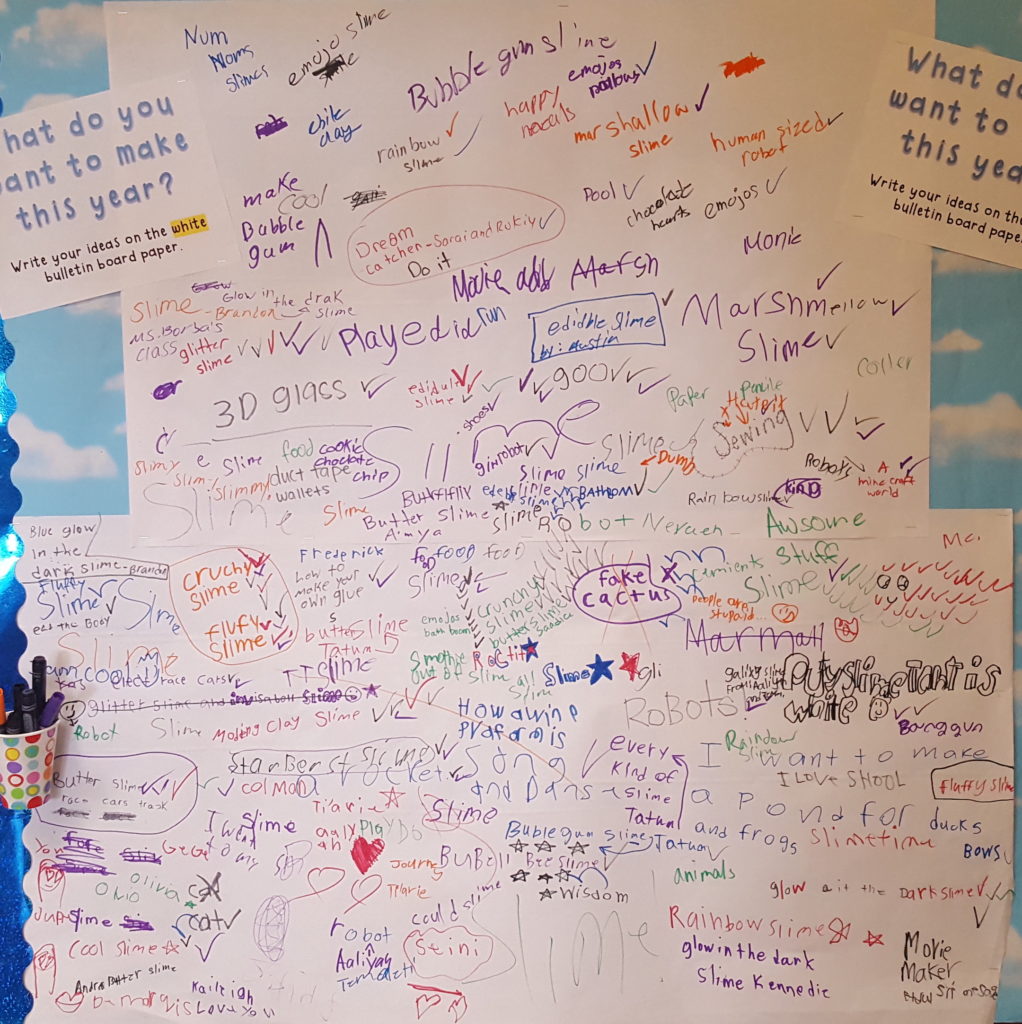 Maker Graffiti Wall- posted outside Grass Valley’s makerspace, the Wonder Workshop, at the beginning of school -August 2017.
Maker Graffiti Wall- posted outside Grass Valley’s makerspace, the Wonder Workshop, at the beginning of school -August 2017.
Not only did we ask students what they wanted to do, we acted on that information.
The first thing the Maker VISTA Team (two new Americorps Maker VISTA members and myself) realized when looking at the graffiti wall poll results was that there was no way we could accommodate all the kids who wanted to make slime during the Recess Making sessions; we would have been at it all year long, nor were teachers inclined to take the time from their schedules to devote an afternoon to slime making. We decided this would be the perfect activity for our first after school making session. Incredibly, once the Maker team advertised the first Slime session, it was filled within a day. We ended up adding two more Slime sessions where over 80 children got to make and take home two different kinds of slime: glow-in-the-dark and fluffy. Each child got the tactile delight of making something from scratch that they had expressed interest in creating.
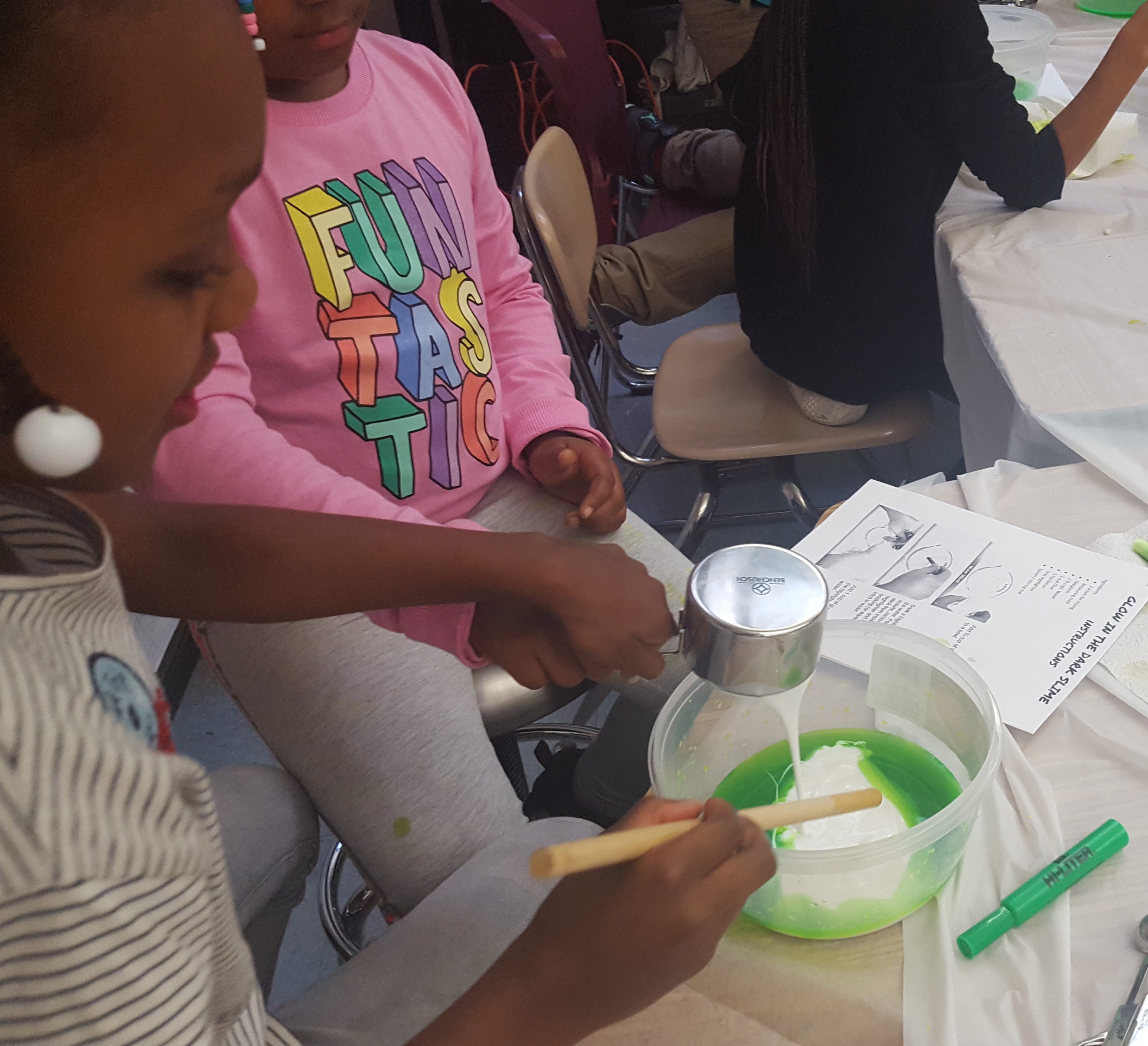 Students measuring and mixing ingredients for Glow-in-the-Dark slime.
Students measuring and mixing ingredients for Glow-in-the-Dark slime.
After the impressive Slime Sessions, the Maker team and I were ready to see what else our students were capable of creating. Our Americorps Maker VISTA members went to work advertising to all classes the availability of Individual Maker Projects during recess.
A completed project plan- once approved students were put on the recess making schedule.
For these individual projects, we provided support in making the student’s vision come to fruition sometimes by teaching a new skill- like cutting cardboard tubes to make towers on a castle, or pointed students to online resources like Youtube videos that show how to sew a doll. Other times, we had students just try things out and see what happened. In maker-centered learning, there is a high value placed on figuring things out on one’s own or within the group. Once students figure out a way to make something work, they forever own that method and are willing to take more risks. These Making projects were also an authentic way for students to learn and practice resilience, perseverance, flexibility, and collaboration. All the 21st century skills that are so highly touted. Just as important, students learn that Making isn’t just for other people, but for everyone. They can make beats, and rhymes, and vending machines, and toys. They become the producers and owners, not just the consumers. This is agency and this is where real change begins. What started out as an experiment the year before, became a cornerstone experience in our Linked Learning through Maker Education initiative.
“Get them while they’re young and bend their minds forever.”- Spencer Dryden
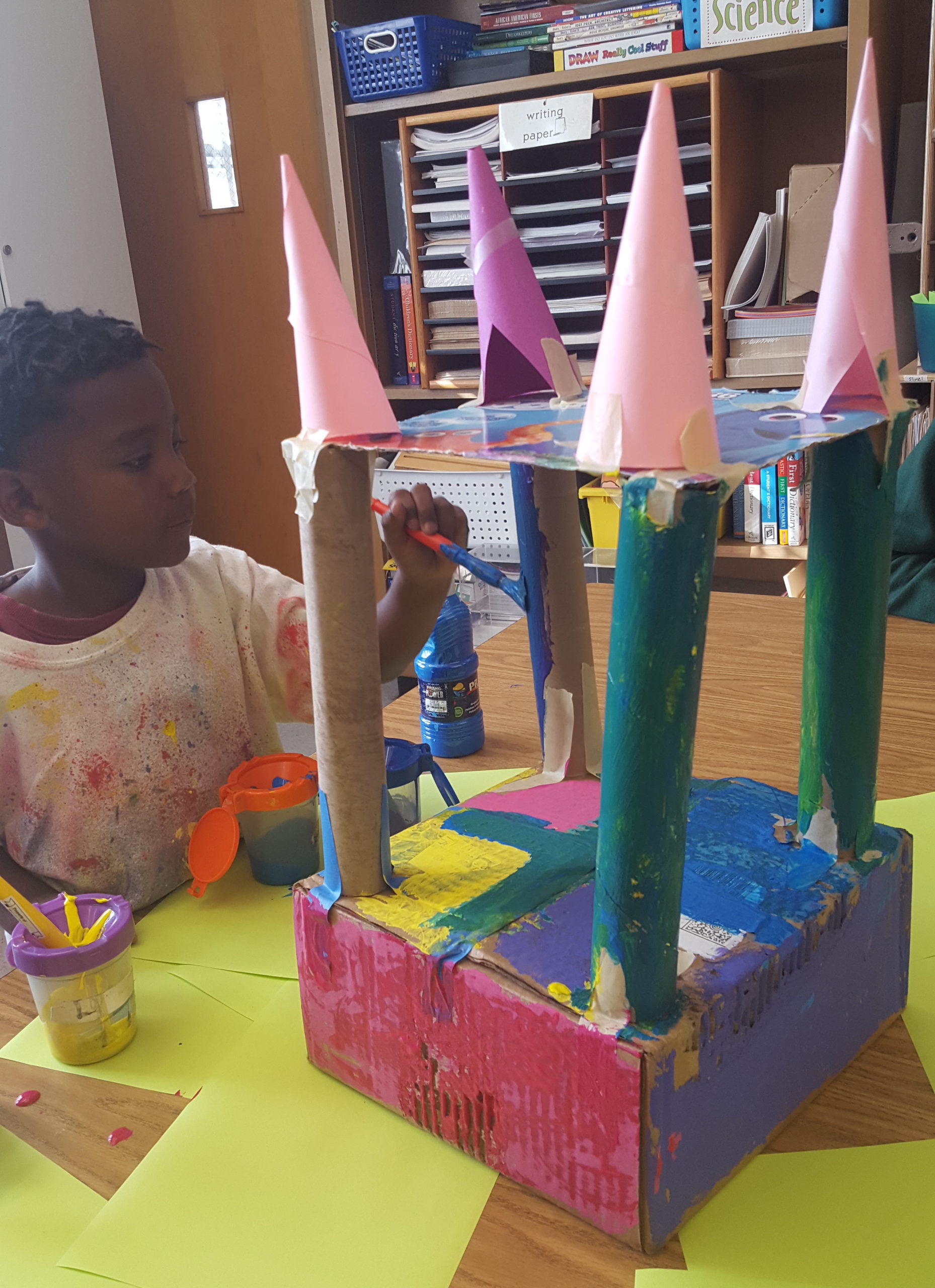 This Kinder student started a castle making craze among the lower elementary students.
This Kinder student started a castle making craze among the lower elementary students.
Second grader making a no sew tutu of her own design.
Second grader creating a Sonic stuffed toy.
Fourth grader showing off her completed Tinkercad designed 3D printed puppy.
Second graders creating a full-sized cardboard vending machine.
To adults, making a castle, a tutu, a plastic puppy or a vending machine may seem silly or inconsequential, but to a small child- it means everything when it’s your idea on the line. When what you want to make is taken seriously, it’s a small step that can have a huge impact to a child’s self-esteem and sense of agency. When a child says, “I want to make this!” and an adult says, “Ok, let’s figure out how you can get it done!” it’s hugely empowering. The fact that students at Grass Valley are doing this as early as four and five years old, we believe has lasting value. These students begin to internalize the worth of their ideas and ask to create more. They begin to see not problems, but opportunities to think creatively and come up with innovative approaches. All because they have a voice in what they do with their time, their minds, and their hands.
A 5th grader designed and built this model car. She wants to design NASCAR race cars when she grows up.
While the Individual Maker Projects have become the unexpected hit of our Linked Learning initiative, it wasn’t the only experience we wanted our students to have. We wanted families to experience the joy of making and understand the value it has right along with core academic subjects. We explicitly wanted families to be able to make together at home.
One of the major issues around access and equity that we have run into is that not all of our students have the tools they need to explore their interests outside of school. One of the key pieces of our Linked Learning through Maker Education initiative was the creation of Library Maker Take Home Kits. We decided to address the issue of equity and access by offering these tools, much like libraries currently offer library books, to students so they can check them out, take them home, and explore their interests and work on projects outside of school.
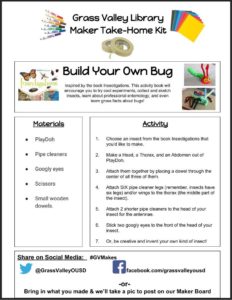 Making prompt page from Grass Valley’s Build a Bug Library Maker Take Home Kit.
Making prompt page from Grass Valley’s Build a Bug Library Maker Take Home Kit.
In the summer of 2017, our Maker Team designed, planned, and created ten Library Maker Take Home Kits. Each kit includes a book, a making prompt and the materials needed to make the project. We had planned to offer these first ten kits in the fall of 2017 on a trial basis, revise them and create additional kits in the winter and spring. Due a number of unforeseen events, we weren’t able to launch the Library Kits as we had planned last year, however we are on track to offer the initial ten plus twelve more this school year. You can check out our Library Maker Take Home Kits and use the included templates to design your own.
As with many aspects of Maker Education and life for that matter, we are in a perpetual cycle of prototyping, testing, refining, and creating. If you are interested in learning more about Grass Valley’s Linked Learning with Maker Education initiative check out our Wonder Workshop blog.


